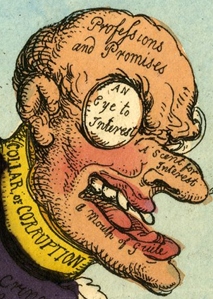All 1 entries tagged The
View all 59 entries tagged The on Warwick Blogs | View entries tagged The at Technorati | There are no images tagged The on this blog
July 12, 2021
'Old Corruption' Revived?
Writing about web page https://www.historyandpolicy.org/policy-papers/papers/old-corruption-revived-lessons-from-the-past
Are we living in an age of ‘New Corruption’ and if so, are there any lessons from our past about what to do about it? ‘Not since the Victorians abolished patronage with open competition has any government so ruthlessly ushered its placemen into every nook and cranny of the public realm’, argues Polly Toynbee [Dido Harding to head the NHS? Her position would be untenable | Polly Toynbee | The Guardian]. She implicitly refers to the mid-nineteenth century waning of ‘Old Corruption’ after an intense period of reform, and the recent revival of old practices.
‘Old Corruption’ – a term coined in the 1830s – was characterised by a ‘system’ of corrupt institutions and practices that diverted public money into the pockets of a political and social elite who distributed offices amongst their friends and family in order to advance their own profit. This article for History and Policy explores how far Old and New Corruption resemble each other; what reforms worked in the past; and what lessons can be learnt from this earlier history.
Here is a short summary of some of its conclusions
- Old Corruption taught us that neither public office nor a contract for outsourced public services should be obtained by patronage, patrimony or partisanship; but also that such forces are remarkably powerful, enduring and difficult to constrain.
- Both informal and formal restraints are necessary to attempt to do so. We need i) a vigorous and widespread debate on public ethics, particularly around issues of self-interest and accountability ii) robust, formal institutions with a remit for reform that remain independent from the executive iii) leadership demonstrating integrity.
- Some of the formal architecture of, and principles underlying, restraint already exist, the legacy of the struggle with Old Corruption; but they need to be protected from erosion and we also need to think about how to meet new challenges.
- We should view corruption not just as an issue of individual moral failing but as a systemic one in which many of our current institutions are interconnected and ripe for wholesale review.
- Anti-corruption is a long-term and on-going process but there are short-term measures that could help. One would be to increase the barriers and constraints on the ways in which vested interests influence public life and seek to determine the public interest.
- Crises and large-scale government spending increase both the opportunities for corruption and (with the consequent tax rises necessary to fund it) the public pressures for reform.

A satire of the ‘nabob’ (an anglicisation of the Indian word for prince), the rapacious Sir Thomas Rumbold, here neutralising his prosecution by showering money into a pot held by a government minister, Henry Dundas. Dundas was himself accused of creating a patronage network of Scottish MPs who would do the government's bidding.© The Trustees of the British Museum
 Mark Knights
Mark Knights

 Please wait - comments are loading
Please wait - comments are loading

 Loading…
Loading…

